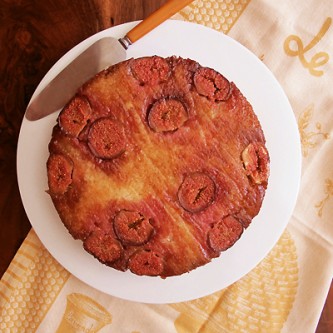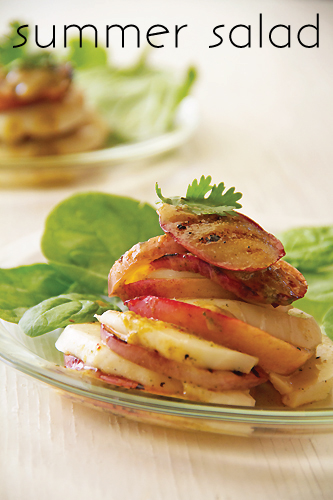Preheat oven to 350 degrees.
Make the rum syrup: Melt 4 tablespoons of the butter in a small sauce pan set over medium heat; stir in ¼ cup sugar. Cook, swirling the pan often, until the sugar dissolves and the liquid turn a medium amber color. Remove from heat and stir in the rum. Set aside.
Butter the insides of a 9‑inch cake pan. Line the bottom of the pan with a parchment round cut to fit edge to edge. Set aside.
Make the cake: In a large bowl sift the flour, baking powder and salt together. Set aside.
In a separate large bowl beat the remaining 8 tablespoons butter with an hand held electric mixer until light in color. Add the remaining 1 cup sugar and continue to beat until fluffy. Add the egg yolks and vanilla and mix them in until just incorporated.
Using a rubber spatula add about ⅓ of the buttermilk to the butter and sugar mixture; stir until just combined. Next add about ½ of the flour mixture; stir until just combined. Repeat with another ⅓ buttermilk and the remaining flour mixture; finish with the remaining buttermilk. Set aside.
In a clean bowl use the hand mixer with clean whisk attachments to beat the egg whites until soft peaks occur. Working in 2 additions, fold the egg whites into the prepared batter. It’s fine if the mixture looks streaky, don’t over mix.
Pour the rum syrup into the prepared pan. Lay the figs (cut side down) evenly spaced in an attractive manner over the syrup. Dollop the batter in several additions even on top of the figs. Try to keep them in place as well as possible. Gently spread the batter to cover the figs.
Bake in the heated oven until the cake is golden and puffed and cooked through in the center, about 40 minutes.
Let cool the cake on a rack about 20 minutes.
To serve: Set a flat serving plate that’s larger than the cake pan upside down on top of the cake pan. Using oven mitts or thick kitchen towels in both hands, hold the plate and cake pan firmly together in front of you. Quickly invert both the plate and the cake pan in one confident motion, letting the cake fall onto the plate. Carefully remove the cake pan allowing the cake to settle in one piece onto the serving plate. Be careful as the syrup may be hot. Gently peel off the parchment. Serve warm or at room temperature.





Oh my gosh, I have made three fig cakes in the last week while working on a recipe. I think making a fig upside-down cake is brilliant. Wish I had figs in my backyard!
Growing up, I had no idea why my mom was so crazy about fig seasons. But now I do understand..when figs are in the baked goods, they are extra good. I am drooling here looking at your fig cake. I love upsidedown cake, and figs are great for that. I need to try this!
I could have written your first paragraph…simply one of my favorites still but I do up the ante with fresh pineapple and my own homemade maraschino cherries! Still; I love the idea and am always looking for new opportunities. I just made a fresh peach upside down cake this week; it was so good I might have to do that again!
We don’t seem to get a lot of figs ‘up here’ but I’m on the hunt; this just sounds too good!
Thank you Greg for posting on the fig hop! I just love the simplicity of this cake!
Well I personally think fig upside down cakes are WAY more magical than pineapple upside downs. Mostly because I think figs are uber enchanting.
I love how easy this is to make! And I’ve just recently fallen in love with figs too!
OMG..Love the cake!
This fig upside down cake looks and sounds delish!
Thanks for sharing the recipe for this mouth watering upside down cake!!
I’m always amazed at the beauty of upside down cakes…and yours is no exception, wanna dive into that golden juicy top.
Lovely upside down cake! It’s been years since I had a slice. The reason is that the upside down cake that I have known is with the yellow cake mix, canned pineapple and maraschino cherries. I need to find a fig tree in my neighborhood too… Do you find that the best time to pick the figs is at night?
Brilliant idea! And a tasty one, too. Love the looks of this, and figs have such great flavor, I know it’s wonderful. Thanks for this.
I grew up on the canned stuff too but something like this is definitely what I’m looking for now. Gorgeous cake!
So you’re still stealing figs? If I was a fruit police officer I’d forego your ticket for a slice of this!
Lucky you to have such a prolific supply of figs. I keep hoping mine will mature before the frost hits. That’s when I shall make this glorious upside down cake”
Absolutely obsessed with upside down cakes over here, so this is definitely worth a go! Lovely idea with the figs!
Oh wow! This cake sounds amazing. I’m not usually one to cook my figs, but I think I may need to try not to just eat my next pint all out of hand so I can give this a try. 🙂
Greg this is gorgeous! Still need to come scavenge your neighborhood for some of those beauties.
The rum is your magical touch…
Oh my lord, I would have to drive to the city to get figs but have a feeling it would be worth it.
I’m sending this recipe to my brother who has a prolific producer of a fig tree in his yard, and who as a kid always had a pineapple upside down cake for his birthday.
If only figs grew in our area Greg…sigh.
PS It is at times like this that I contemplate moving to California.